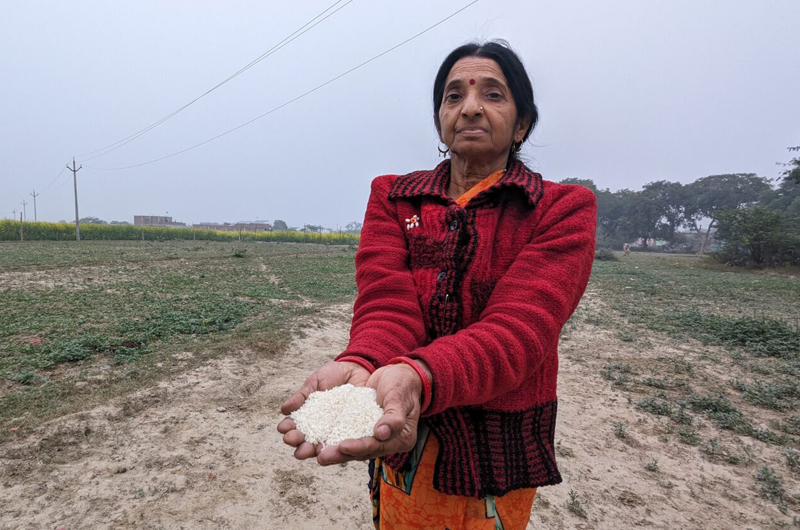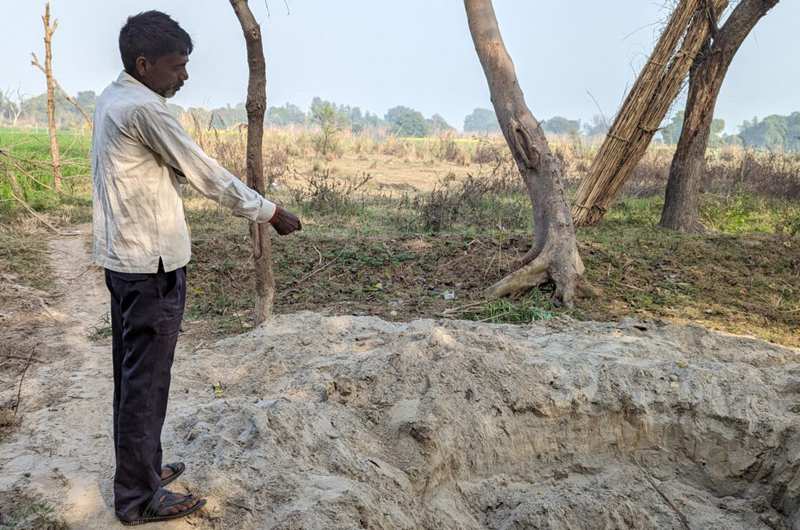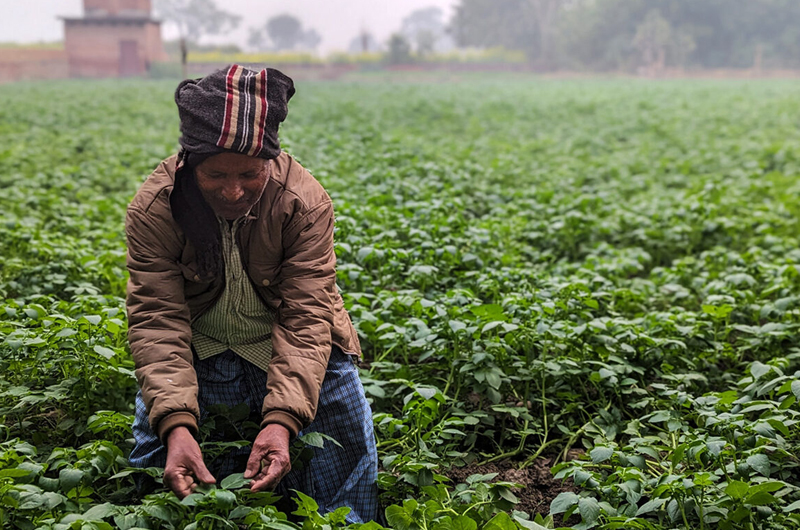Farmers in Unnao, Uttar Pradesh, have moved from cultivating traditional pulses to growing paddy, which, so far, has not been a common crop in the region. Damage by stray cattle and unpredictable rainfall, aided by access to low-cost irrigation techniques, is facilitating the shift in crops. Experts point out that subsidised electricity access for irrigation pumps could impact groundwater in the long term. This report is by Aishwarya Tripathi
Sushma Pandey, a 56-year-old farmer from Hafizabad Village in Unnao, Uttar Pradesh, is keen to grow arhar (pigeon pea) on her 0.5 hectares of land. However, two challenges prevail: open grazing by stray cattle and unpredictable rainfall. In 2022 she lost her pulses crop to heavy rain. Then, in 2023, discouraged by the recurring loss of the pigeon pea crop, Pandey decided to try growing paddy instead. She also planted urad (split black gram) and moong (green gram beans) on one hectare of land. However, once again, she lost the entire crop of pulses to damage by heavy rain as well as stray cattle. Unnao was one of the thirteen districts in Uttar Pradesh affected by heavy rainfall on September 10 and 11, 2023.

Farmer across several blocks in Unnao District are transitioning from pulses to paddy. According to block-level agriculture officials, almost 30 villages from Miyaganj, Hasanganj, Hilauli, Sikanderpur Karan, Achalganj and Sikanderpur Sarosi Blocks in Unnao have moved to the water-intensive crop over the last six to eight years. Before that, paddy was not extensively grown in the region. “There are multiple reasons behind this shift, with the primary factor being the sensitivity of pulses to changing rainfall patterns. Growing pulses is a gamble and with convenient irrigation methods like electricity-run and solar pumps, farmers who did not opt for paddy earlier due to expensive diesel pumps are now able to choose the crop during kharif,” explains Kuldeep Mishra, district agriculture officer (DAO), Unnao.
Acknowledging the shift in cultivation patterns, Dheeraj Tiwari, a scientist at Krishi Vigyan Kendra (KVK), Unnao, says that paddy and wheat are more adaptable to changing rainfall trends compared to urad, til (sesame) and moong. “With the changing climate, we observed monsoon, followed by almost one and a half months of dry spell, succeeded by almost a week of heavy rainfall in October. With an 85-day maturity cycle, October is the time when urad and moong are to be harvested but October rain destroys the entire ripe crop,” he tells Mongabay-India.
Over the past 15 years, the state government’s target for paddy acreage in the Unnao District, surged from 56,056 hectares in 2009 to 97,474 hectares in 2023 – a 73.8 per cent increase. In contrast, the target acreage for pigeon pea crop declined from 3,067 hectares in 2009 to 2,844 hectares in 2023, reflecting a 7.27 per cent drop during the same period. The national trend also showed a 16.2 per cent rise in paddy sowing during kharif in 2023, while the pulses acreage shrank by 10.6 per cent in 2023, compared to 2022.
Unfavourable weather
As in 2023, farmers in Unnao experienced heavy rainfall in 2022 and 2021 too. Talking about the situation in 2021, DAO Mishra says, “There was so much rainfall in late August that the agricultural fields had water-logging. The urad and moong, which were sown in early June, germinated in the pod itself.” In that season of 2021, “farmers who chose to grow urad and moong harvested half a quintal of these pulses in a 0.63-acre area, though the normal produce should be about 5-7 quintals,” he says, adding that paddy is a safe choice and also provides food security to farmers.
“The impact of climate change is more prominent for pulses than paddy. The rainfall has been so unpredictable in the past few years — unavailable when needed, and then showing up when it is most useless for the crops,” Pandey says. In a 0.63 acre of land, Pandey has to invest Rs 20,000 to grow paddy and Rs 2,000 to grow the pigeon pea. “But the paddy at least gives some surety of earning,” she said. This assurance is important for farmers like Pandey, who need to pay a fixed amount to the landowner, irrespective of their losses.
Stray cattle compound agricultural challenges
Around 30 kilometres away from Hafizabad, Raju in Pancham Purwa Village, located a stone’s throw away from the River Ganges, had never considered cultivating paddy in the sandy soil of the region. “Dig five feet from here and you will find only sand,” said the tenant farmer Raju, who goes by a single name. He cultivates on land through crop sharing. Pointing at the land, currently covered with wheat saplings, he says, “It is hard to grow paddy here because the soil absorbs water and paddy needs completely submerged land throughout the growth cycle. The more the water, the better the crop. In the scorching heat of June, the water evaporates so quickly that I need to provide water every five to seven days. Almost 16 cycles of this,” he says with a sigh. “But the stray cattle leave me with no choice.”

Paddy grows best in clayey soil due to its high capacity for holding water compared to sandy or loamy soil. “Sandy soil has no binding property thus the agricultural inputs leech out of the soil. Practising paddy cultivation in areas with sandy soil like that of Pancham Purwa requires excess input of water, fertilisers, and chemicals, which could impact both groundwater levels as well as soil structure and texture,” says Mishra, the agriculture officer.
“This sandy soil is favourable to cultivating varieties of millets and fruits like watermelons, muskmelons, etc. But in the long run, this forced effort to grow paddy will make the soil unfit to grow even the favourable crops,” he claimed. Stray cattle destroying crops has emerged as a major challenge in Uttar Pradesh and has become a political issue.
Cereal crops like wheat and paddy are also prone to open grazing, but “in the beginning 1.5 months of sowing, they have regenerative capacity and the grazing helps in pruning of the crops, thus increasing the crop produce,” explained Mishra. “Pulses lack this capability and are extremely sensitive to weather as well as open grazing.” Due to the lower height of the paddy crop, compared to pigeon pea, it is easier to guard a paddy field.
Subsidised irrigation, more paddy
Chhotelal, a 76-year-old farmer, was among the first ones to try growing paddy crop after losses from arhar, urad and moong crops damaged by stray cattle for three consecutive years. He brought in the knowledge from the paddy farmers in Makhi Village, six years ago. Farmers like Pandey who are recently moving to paddy cultivation consult him on the ins and outs of the process. Although paddy is sown just before the southwest monsoon arrives in June, Chotelal relies on borewell-facilitated irrigation for the crop. “Paddy requires submerging my land six times for a good output. The rains are never enough and I depend on an electricity-run pump for irrigation,” he said.
Until 2017, Chotelal depended on a surface diesel-run pump set for irrigation, but with rising fuel costs and the “inability of these surface pump sets to provide an abundant, continuous supply of groundwater,” he switched to an electricity submersible pump set. “Diesel pump sets were expensive. The costs would mount to Rs 2000 to irrigate 0.66 acre of land for six to eight hours. To grow paddy on my 1.25 acres, requiring irrigation six times during the crop cycle, I would have to shell out Rs 24,000. I would never recover such an input cost from selling paddy. If it weren’t for the electricity pump set, I wouldn’t grow paddy,” the septuagenarian explains.
“This low-cost irrigation and abundant water availability are good for paddy,” says Chhotelal. He pays a fixed monthly electricity bill of Rs 1490 to irrigate for however long he wishes to. Ahead of the state assembly polls in 2022, the Uttar Pradesh government had also announced a 50 per cent subsidy on the electricity bills of private tubewell consumers. This brought down the cost to Rs 745 for farmers like Chotelal. Furthermore, under the financial budget of 2023-2024, a provision of Rs 1,500 crore was announced, raising the subsidy for the electricity tubewell users to 100 per cent. But, Chhotelal claims that he is still paying 50 per cent of the total bill. “These subsidised irrigation facilities tend to push farmers to over-irrigate,” claims Kuldeep Mishra, DAO, Unnao.

Dynamics of groundwater
One kilogram of harvested rice utilises 900 litres of water during the entire crop cycle, says KVK scientist, Tiwari. However, considering that all the blocks of Unnao District are indicated under the ‘safe’ category, based on the assessment by the Central Groundwater Board (CGWB), he does not see a groundwater crisis anytime soon. “However, in the long term, paddy cultivation and over-irrigation from the borewells could lead to a groundwater problem,” he added.
“In regions of surplus groundwater like Unnao, it is recommended that the farmers utilise this natural resource, which would allow the aquifers to absorb water during flooding. As long as the recharge rate post-monsoon is good, it shouldn’t be a problem,” Shilp Verma, senior researcher, Water-Energy-Food Policy at the International Water Management Institute (IWMI), tells Mongabay-India. “However, when farmers have subsidised or free electricity, they have the incentive to keep pumping. This could also be the case for an off-grid solar pump. This excessive pumping translates to groundwater exploitation in the future,” he warns.
A report titled State of Groundwater in Uttar Pradesh launched in 2021, has highlighted the issue of salinity and a high concentration of fluoride and arsenic in the underground water reserves in Unnao. “Water contamination problems such as fluoride and arsenic happen due to geogenic reasons (originating from within the earth or geological processes), their source being the soil itself. Overuse of groundwater is one major factor that results in excess usage and release of such contaminants,” says Sunderrajan Krishnan, executive director of Gujarat-based India Natural Resource Economics and Management (INREM) Foundation, while talking to Mongabay-India.
But beyond groundwater, cultivating cereals in both crop cycles could mean a domino effect on the soil, as pointed out by Ratna Sahay, a soil scientist at KVK, Unnao. “Pulses are important to maintain the soil nutrient balance, and if wheat and paddy are grown subsequently, this could eventually make essential soil microbes disappear, reducing the fertility of the land as well as crop production,” Sahay tells Mongabay-India. Verma from IWMI noted that this shift seems more of a desperation than a calculated choice. “More than groundwater, this is bad from the agricultural economics point of view,” he said.
(Courtesy: Mongabay-India/ india.mongabay.com)



 from Webdoux
from Webdoux